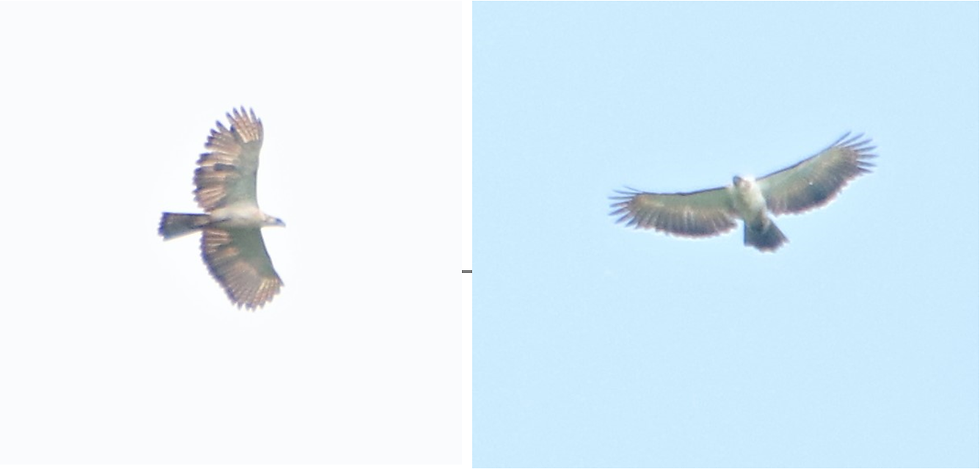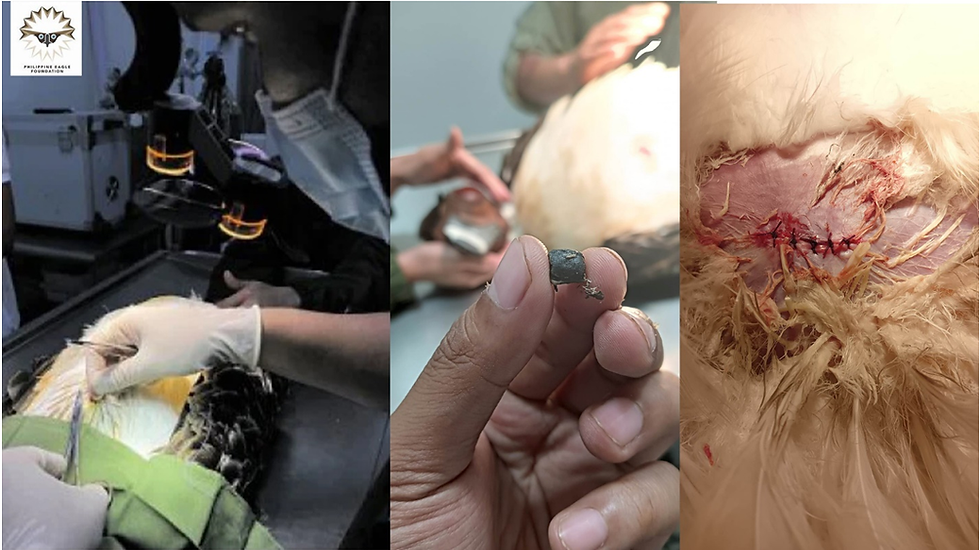By Rowell L. Taraya, Andrei Von Tirona, Jimbea Lucino, Dominic Tadena, and Jayson C. Ibanez, PhD

Introduction
The Philippine Eagle (Pithecophaga jefferyi) is one of the largest and most impressive forest eagles in the world. It is found only in the Philippines, where it is the national bird. As the largest bird predator of the skies and natural forests of the country, some Indigenous peoples of the Philippine highlands fear and revere the species, with the eagle valorized in the epics and origin stories of some groups (e.g. Bagobo Tagabawa of Mt Apo, the Manobo of North Cotabato, and the Isnag of Apayao).
But sadly, this remarkable predator is listed by IUCN as “critically endangered” (BirdLife International, 2018), which means that it is on the brink of extinction. With no more than 392 adult pairs existing now (Sutton, et al., 2023), any effort to save and protect each individual bird is therefore important.
In December, 2013, a nestling was hatched at an eagle nest site in Mt Apo, Davao City. The chick was later named “Sinabadan”, after the local organization “Sinabadan Kaag Tugallan” – an Indigenous Bagobo Tagabawa association of the traditional owners of the eagle nest site at Mt Apo. The association’s volunteer forest guards took turns guarding the forests of the Bagobo Tagabawa ancestral domain, as well as its resident Philippine eagles.
In 2014, the one-year old, female eagle Sinabadan was trapped and instrumented with a GPS tracker by PEF. In the same year, both its male and female parents were also trapped and given their respective GPS trackers. Unfortunately, Sinabadan lost her father to shooting when she was just a year old. She was therefore raised only by the female eagle. Fortunately, the female eagle coped and raised Sinabadan successfully, until she left her parent’s territory in 2016. Before she left Mt Apo, Sinadaban’s old GPS tracker was replaced with a new solar powered GPS/GSM transmitter.
After leaving her nest site, she has dispersed actively and nearly circumnavigated the Mt Apo Range. In 2017, she left Mt Apo totally, and for the next three years have explored both small and large forest patches in North Cotabato, Bukidnon and Davao Del Norte. During her dispersal, she also used riverine forests along Pulangi and Davao Rivers as her flight corridors, perhaps also as a cover against possible human harm. She also seemed to have hunted for prey items along these riparian forests (see image below).

Sinabadan’s last location was at the northern slopes of Mt Tangkulan in San Fernando, Bukidnon based on GPS coordinates from her satellite transmitter last January 2023, which is over 100 km away (aerial distance) from where she was hatched. She will turn ten-years-old come December, 2023, and at such age, she is already sexually mature.
From January 31 to March 9, 2021 PEF field monitoring at Mt Tangkulan, Sitio Sagulayan, Brgy Kibongkog, San Fernando, spotted Sinabadan with another wild Philippine Eagle.The two eagles did mutual soaring, mutual cruise behaviours for several times and on one instance, even talon presentation behaviour. This set of behaviors is associated with a potential pairing attempt.

Activity Results
Rescuing a weak eagle
On the night of February 24, 2023, our field team received a report about a Philippine eagle that was captured at Mt Tangkulan in Sitio Blaas, Barangay Mabuhay, San Fernando, Bukidnon. Rosmie Odal, the PEF’s Local Community Organizer (LCO) from Mabuhay texted that she received a radio message from the forest guards about a caged eagle. The eagle had a blue band around its leg and a GPS transmitter on its back.
Immediately, our team led by Jimbea Lucino - PEF Culture-based Conservation Manager - who were then in Malaybalay for a community workshop responded. Joined by LGU San Fernando Tourism Staff Michael Mendio, Manobo-Tigwahanon Forest guards, and BLGU Mabuhay representatives, the team left Malaybalay at dawn of February 25. Hours later, our Senior Biologist Ron Taraya and Senior Animal Keeper Dominic Tadena from Davao City arrived in Sitio Blaas with their rescue gears and first aid kit.
Our team drove until Sitio Balao only. From there, they took a 20-minute motorcycle ride to Sitio Blaas. The team thought at first that the eagle was at Sitio Blaas already. It was only when they got off their motorcycles that they found out they needed to walk two-and-a-half hours more to get to the eagle. They hiked a total of 3.69 kilometers to get to what locals called the “Bulon Area” where “Sinabadan” was. Most of the hike was across a deforested landscape, with the last segment of the walk through thick jungles on steep slopes. The team reached Bulon at 0800 hours where they found Sinabadan in a small hut in the middle of the forest.

Lucino interviewed the eagle captors who narrated how they caught the eagle. They reportedly took notice of the bird on the morning of February 24 while cleaning their banana farm. They heard a big “splash” from a creek, which they inspected. And there soaked in water is a large bird strongly flapping its wings in a desperate attempt to get out and perhaps avoid drowning. With the help from their neighbors, they scooped the eagle out of the creek.

They said the eagle was too weak to resist capture. They then tied the bird’s legs and tethered it inside a nearby hut. They then radioed the Sitio Leader of Blaas for help.
Ron and Dominic arrived at Bulon around 0900 hours on February 25. They safely restrained the bird and did a standard physical assessment. While doing a routine eye inspection, Dominic noticed cloudiness in the right eye of the eagle, which is a telltale for cataract.
The bird was also thin (Body Condition Score of 2), dehydrated and had a prominent keel bone. The eagle’s weighed 4.9 kgs, which is an “underweight” considering that she weighed 6.5 kgs in 2016. With the bird in bad shape, eagle Sinabadan needed more tests and urgent medication. The team decided to take Sinabadan to Davao City where she will be admitted at the Philippine Eagle Center for full care and rehabilitation. Prior to transporting the bird, Dominic injected 30 ml of intravenous fluids on each leg to rehydrate the eagle.

Around 1030 hours, the whole team left Bulon with the eagle. Each team member took turns carrying Sinabadan to the car. Under the scourging heat of the sun, each carrier carefully cradled the bird and held an umbrella to protect it from getting further dehydrated. The bird’s eyes were also covered with a hood and its wings and body wrapped in cloth. With an extra load, the team was slower, and it took them a total of 3.5 hrs to finally reach the car.
After quickly passing by the office of Punong Barangay of Mabuhay and CENRO Valencia, the team left Bukidnon at 1700 hours. By 2100 hours, the bird was admitted at the Doc Bayani’s Animal Wellness Clinic in Davao City where he was further examined and treated by Dr. Bayani Vandenbroeck and his team.
Medical Checkup
At the clinic, our vet consultants measured the heart and breathing rates of Sinabadan, which were normal. Interestingly, she was calm and showed no signs of panting or stress. Her ears, mouth, and talons were clean, with no sign of any serious injury, except for superficial cuts on the No.3 digit of its right talons. Both left- and right-wing feathers as well as tail feathers were complete, with some growing wing and tail feathers. Sinabadan was re-weighed and her “underweight” and “malnourished” conditions were validated. Blood samples were then collected for disease and parasite screening, and for DNA sexing and studies.
A “papillary reflex response” test showed that the right eye of Sinabadan was unresponsive due to cataract. The left eye also showed early signs of cataract, but it was still responsive. Blindness in its right eye and its failure to hunt efficiently because of this appears to be the major cause of her weight loss.
Dr. Vandenbroeck also did x-ray examination and the eagle’s plates showed 3 air gun pellets embedded inside the eagle’s frail body. One pellet was inside its abdomen near the ventral area; one was superficially located at the left leg; and one pellet was on the chest. Above the last pellet was a fresh entry wound. Based on the wound’s appearance and hematoma, the wound is only very recent (within the last five days). Photographic examination by a ballistic expert from the PNP crime laboratory in Camp Crame confirmed that the pellets were designed for air gun use.
Dr. Vandenbroeck surgically removed the two pellets (one on the leg and the other on the chest). To lessen pain and discomfort, local anesthesia was applied. He left the last pellet untouched because it was deep in the abdomen. After the operation, Dr Vandenbroeck prescribed anti-inflammatory medicine, antibiotics, and vitamins for Sinabadan’s fast recovery during rehabilitation.

Around 12:00 AM of February 26, 2023, Sinabadan arrived at the Philippine Eagle Center where she was housed at the center’s quarantine and rehabilitation quarters. Dominic hand-fed her with 100 grams of pink meat from White Rats soaked with vitamins before setting her free inside her rehabilitation enclosure.
Rehabilitation at PEC
Sinabadan is currently under rehabilitation and is given a daily ration of rabbit meat (300 grams).
FUTURE PLANS
The team will coordinate with its DENR X, CENRO Valencia and LGU counterparts, including the Philippine National Police and the Philippine Army for a formal investigation of the incident. The PEF will also connect with LGU San Fernando for a possible local ordinance that will confiscate and ban air guns and firearms within a certain radius of Philippine eagle habitats in San Fernando. More education campaigns (Behavioral Change Campaigns) and community-based outreach work will also be undertaken at Mabuhay and all other eagle areas in San Fernando.
ACKNOWLEDGMENT
We thank the Local Government Unit of San Fernando Bukidnon led by their Municipal Mayor Rogelio C. Yeke for their unending support and partnership through the years. We also thank the MENRO and Tourism Offices of LGU San Fernando. We also extend our deepest gratitude to the DENR CENRO Valencia City, Bukidnon and the BLGU of Barangay Mabuhay, San Fernado Bukidnon. The forest guards of Barangay Mabuhay and the tribal leaders from San Fernando Bukidnon were very supportive during the rescue of the eagle. The forest guard program and rescue of eagle Sinabadan is supported by USAID-INSPIRE.


Please keep her in captivity the rest of her life where she will be safe and well taken care of. With her eye condition, she will no longer be able to hunt effectively and will surely perish in the wild.
I loved how you narrated the story and rescue of Sinabadan. Kudos to all of you, from the writer to rescuers to vets and everybody else. THANK YOU!